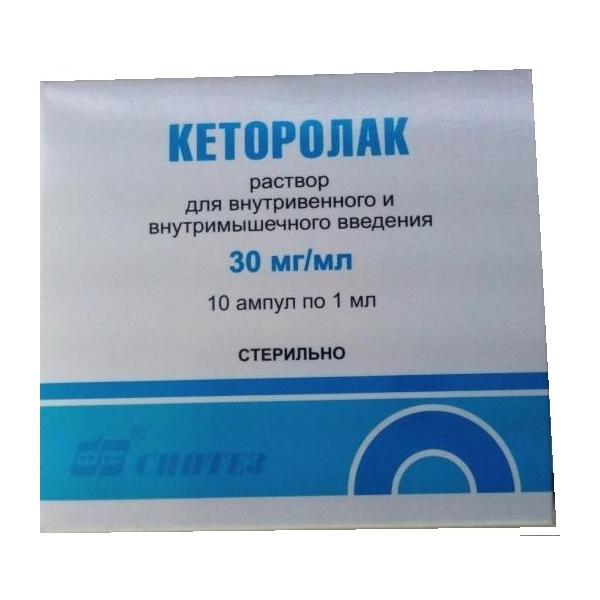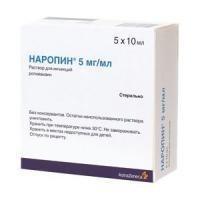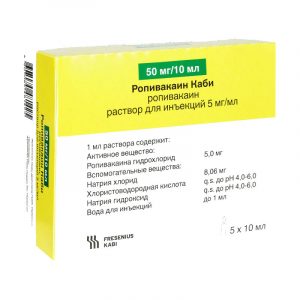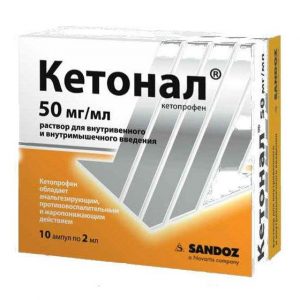Description
Release form
injection
Pharmacological action
Ketorolac has a pronounced analgesic effect, also has anti-inflammatory and moderate antipyretic effect. The mechanism of action is associated with non-selective inhibition of the activity of the enzyme cyclooxygenase 1 and 2, mainly in peripheral tissues, which results in inhibition of the biosynthesis of prostaglandins – modulators of pain sensitivity, thermoregulation and inflammation. Ketorolac is a racemic mixture of [-] S and [+] R enantiomers, with the analgesic effect being due to the [-] S form. The strength of the analgesic effect is comparable to morphine, significantly superior to other non-steroidal anti-inflammatory drugs. The drug does not affect opoid receptors, does not inhibit respiration, does not cause drug dependence, does not have a sedative and anxiolytic effect. After intramuscular administration, the onset of analgesic action is observed after 0.5 hours, the maximum effect is achieved after 1-2 hours.
Pharmacokinetics
Bioavailability – 80-100%, absorption with intramuscular administration is complete and fast. After intramuscular administration of 30 mg, the maximum plasma concentration is (Cmax) 1.74-3.1 μg / ml, 60 mg – 3.23-5.77 μg / ml, the time to reach the maximum concentration, respectively – 15-73 min and 30-60 min Cmax after intravenous infusion of 15 mg – 1.96-2.98 μg / ml, 30 mg – 3.69-5.61 μg / ml. The time to reach equilibrium concentrations (Css) with parenteral administration is 24 hours when administered 4 times a day (higher than subtherapeutic) and is 15 mg for intramuscular administration – 0.65-1.13 μg / ml, 30 mg – 1.29-2 , 47 μg / ml, with intravenous infusion of 15 mg – 0.79-1.39 μg / ml, 30 mg – 1.68-2.76 μg / ml. 99% of the drug binds to plasma proteins and with hypoalbuminemia, the amount of free substance in the blood increases.
Distribution volume is 0.15-0.33 l / kg. In patients with renal failure, the volume of distribution of the drug may increase by 2 times, and the volume of distribution of its R-enantiomer – by 20%. Passes poorly through the blood-brain barrier, crosses the placenta (10%). In small quantities found in breast milk. More than 50% of the administered dose is metabolized in the liver with the formation of pharmacologically inactive metabolites. The main metabolites are glucuronides, which are excreted by the kidneys and p-hydroxyketorolac.
It is excreted by 91% by the kidneys (40% in the form of metabolites), 6% – through the intestines. The half-life (T1 / 2) in patients with normal renal function is on average 5.3 hours (3.5 9.2 hours after i / m administration of 30 mg, 4 7.9 hours after intravenous administration of 30 mg). T1 / 2 lengthens in elderly patients and shortens in young patients. Liver function has no effect on T1 / 2. In patients with impaired renal function with a creatinine concentration in blood plasma of 19-50 mg / l (168-442 mmol / l) T1 / 2 is 10.3-10.8 hours, with more pronounced renal failure – more than 13, 6 hours. The total clearance for i / m administration of 30 mg is 0.023 l / kg / h (0.019 l / kg / h in elderly patients), intravenous infusion of 30 mg is 0.03 l / kg / h in patients with renal failure with a creatinine concentration in the blood plasma of 19-50 mg / l with an intramuscular injection of 30 mg – 0.015 l / kg / h. It is not excreted by hemodialysis.
When administered, Ketorolac is well absorbed in the gastrointestinal tract – the maximum plasma concentration (Cmax) (0.7-1.1 μg / ml) is reached 40 minutes after a fasting dose of 10 mg. Food rich in fats reduces the maximum concentration of the drug in the blood and delays its achievement by 1 hour. 99% of the drug binds to plasma proteins and with hypoalbuminemia, the amount of free substance in the blood increases. Bioavailability is 80-100%. The time to reach equilibrium concentration (Css) when administered orally is 24 hours when administered 4 times a day (higher than sub-therapeutic) and is after oral administration of 10 mg – 0.39-0.79 μg / ml. The volume of distribution is 0.15-0.33 l / kg. In patients with renal failure, the volume of distribution of the drug may increase by 2 times, and the volume of distribution of its R-enantiomer – by 20%.
Penetrates into breast milk: when the mother takes 10 mg of ketorolac, Cmax in milk is reached 2 hours after the first dose and is 7.3 ng / ml, 2 hours after the second dose of ketorolac (when using the drug 4 times a day) – is 7.9 ng / ml. More than 50% of the administered dose is metabolized in the liver with the formation of pharmacologically inactive metabolites. The main metabolites are glucuronides, which are excreted by the kidneys and p-hydroxyketorolac. It is excreted by 91% by the kidneys, 6% – through the intestines. The half-life (T1 / 2) in patients with normal renal function is on average 5.3 hours. T1 / 2 increases in elderly patients and shortens in young patients. Liver function has no effect on T1 / 2. In patients with impaired renal function with a creatinine concentration in plasma of 19-50 mg / l (168-442 mmol / l). T1 / 2 – 10.3-10.8 hours, with more severe renal failure – more than 13.6 hours. It is not excreted by hemodialysis.
Indications
Pain syndrome of severe and moderate severity: injuries, toothache, pain in the postoperative period, cancer, myalgia, arthralgia, neuralgia, sciatica, dislocations, sprains, rheumatic diseases.
Designed for symptomatic therapy, reduce pain and inflammation at the time of use, does not affect the progression of the disease.
Contraindications
Hypersensitivity to ketorolac, a complete or incomplete combination of bronchial asthma, recurrent polyposis of the nose and paranasal sinuses and intolerance to acetylsalicylic acid or other non-steroidal anti-inflammatory drugs (including history of anamnesis, history of anesthesia, (history), dehydration.
Intolerance to drugs of the pyrazolone series, hypovolemia (regardless of the cause), bleeding or a high risk of their development, condition after coronary artery bypass grafting, confirmed hyperkalemia, inflammatory bowel disease.
Erosive-ulcerative lesions of the gastrointestinal tract in the acute stage, peptic ulcers, hypocoagulation (including hemophilia).
Severe hepatic and / or renal failure (creatinine clearance less than 30 ml / min).
Hemorrhagic stroke (confirmed or suspected), hemorrhagic diathesis, impaired hematopoiesis.
Pregnancy, childbirth and lactation.
Children under 16 years old.
The drug is not used for pain relief before and during surgery due to the high risk of bleeding, as well as for the treatment of chronic pain.
Use during pregnancy and lactation
Ketorolac is contraindicated in pregnancy, lactation, and children under 16 years of age.
Special instructions
When used together with other non-steroidal anti-inflammatory drugs, fluid retention, decompensation of cardiac activity, and arterial hypertension may occur. The effect on platelet aggregation ceases after 24-48 hours.
Hypovolemia increases the risk of adverse reactions from the kidneys. If necessary, it can be prescribed in combination with narcotic analgesics.
Ketorolac is not recommended as a means for sedation, supporting anesthesia and analgesia in obstetric practice.
Do not use simultaneously with paracetamol for more than 5 days. Patients with blood clotting disorders are prescribed the drug only with constant monitoring of the platelet count, especially in the postoperative period, requiring careful monitoring of hemostasis.
It is recommended to avoid work that requires increased attention and a quick reaction (driving vehicles, working with machinery, etc.).
Composition
1 ml injection contains: active ingredient: ketorolac trometamol (ketorolac tromethamine) – 30 mg.
Dosage and administration
Introduced deep into the muscle, slowly (or intravenously) for at least 15 seconds at the minimum effective dose, selected in accordance with the intensity of the pain and the patient’s response. If necessary, at the same time, opoid analgesics in reduced doses can be additionally prescribed.
Single doses with a single intramuscular or intravenous administration: – for adults under 65 years old and children over 16 years old – 10-30 mg depending on the severity of the pain syndrome, – for adults over 65 years old or with impaired renal function – 10-15 mg. Doses for repeated parenteral administration: intramuscularly – adults under 65 years old and children over 16 years of age are administered 10-60 mg in the first administration, then 10-30 mg every 6 hours (usually 30 mg every 6 hours), adults over 65 years or with impaired renal function – 10-15 mg every 4-6 hours intravenously – adults under 65 years old and children over 16 years old are injected 10-30 mg, then 10-30 mg every 6 hours, with continuous infusion using an infusator, the initial dose is 30 mg, and then the infusion rate is 5 mg / h, – Adults over 65 years old or with impaired renal function injected 10-15 mg every 6 hours.
The maximum daily dose for adults under 65 years of age and children over 16 years of age should not exceed 90 mg, and for adults over 65 years of age or with impaired renal function – 60 mg for both intramuscular and intravenous routes. Continuous intravenous infusion should not last more than 24 hours. With parenteral administration, the duration of the course of treatment should not exceed 5 days. When switching from parenteral administration to oral administration, the total daily dose of both dosage forms on the day of transfer should not exceed 90 mg for adults under 65 years old and children over 16 years old and 60 mg for adults over 65 years old or with impaired renal function. In this case, the dose of the drug in tablets on the day of transition should not exceed 30 mg.
Side effects
Often – more than 3%, less often – 1-3%, rarely – less than 1%.
From the digestive system: often (especially in elderly patients over 65 who have a history of erosive and ulcerative lesions of the gastrointestinal tract) – gastralgia, diarrhea less often – stomatitis, flatulence, constipation, vomiting, a feeling of fullness of the stomach rarely – nausea , erosive and ulcerative lesions of the gastrointestinal tract (including with perforation and / or bleeding – abdominal pain, spasm or burning in the epigastric region, blood in the stool or melena, vomiting with blood or coffee grounds type, nausea , heartburn, etc.), cholestatic I jaundice, hepatitis, hepatomegaly, acute pancreatitis.
From the urinary system: rarely – acute renal failure, lower back pain with or without hematuria and / or azotemia, hemolytic uremic syndrome (hemolytic anemia, renal failure, thrombocytopenia, purpura), frequent urination, increased or decreased urine volume, nephritis, edema of renal origin.
On the part of the sensory organs: rarely – hearing loss, tinnitus, visual impairment (including blurred visual perception).
From the respiratory system: rarely – bronchospasm or dyspnea, rhinitis, pulmonary edema, laryngeal edema (shortness of breath, shortness of breath).
From the side of the CHC: often – headache, dizziness, drowsiness, rarely aseptic meningitis (fever, severe headache, cramps, stiff neck and / or back muscles), hyperactivity (mood changes, anxiety), hallucinations, depression, psychosis.
From the cardiovascular system: less often – increased blood pressure, rarely fainting.
From the hemopoietic organs: rarely – anemia, eosinophilia, leukopenia.
From the hemostatic system: rarely – bleeding from a postoperative wound, nosebleeds, rectal bleeding.
From the skin: less often – skin rash (including maculopapular rash), purpura, rarely – exfoliative dermatitis (fever with or without chills, redness, tightening or flaking of the skin, swelling and / or tenderness of the tonsils), urticaria, Stevens syndrome Johnson’s Lyell Syndrome.
Local reactions: less often – burning or pain at the injection site.
Allergic reactions: rarely – anaphylaxis or anaphylactoid reactions (discoloration of the face, itchy skin, tachypnea or dyspnea, edema of the eyelids, periorbital edema, shortness of breath, difficulty breathing, heaviness in the chest, wheezing).
Other: often – swelling (face, legs, ankles, fingers, feet, weight gain) less often – excessive sweating, rarely – swelling of the tongue, fever.
Drug Interactions
Concomitant use of ketorolac with acetylsalicylic acid or other non-steroidal anti-inflammatory drugs, calcium preparations, glucocorticosteroids, ethanol, corticotropin can lead to the formation of ulcers of the gastrointestinal tract and the development of gastrointestinal bleeding. Joint administration with paracetamol increases nephrotoxicity, with methotrexate – hepato- and nephrotoxicity. The combined appointment of ketorolac and methotrexate is possible only when using low doses of the latter (control the concentration of methotrexate in blood plasma).
With the use of ketorolac, a decrease in the clearance of methotrexate and lithium and an increase in the toxicity of these substances are possible. Concomitant administration with indirect anticoagulants, heparin, thrombolytics, antiplatelet agents, cefoperazone, cefotetan and pentoxifylline increases the risk of bleeding. Reduces the effect of antihypertensive and diuretic drugs (synthesis of prostaglandins in the kidneys decreases). When combined with opioid analgesics, the doses of the latter can be significantly reduced, since their effect is enhanced. The hypoglycemic effect of insulin and oral hypoglycemic drugs increases (dose recalculation is necessary).
Co-administration with valproic acid causes impaired platelet aggregation. Increases the plasma concentration of verapamil and nifedipine. When prescribed with other nephrotoxic drugs (including gold preparations), the risk of developing nephrotoxicity increases. Probenecid and tubular secretion blocking drugs decrease the clearance of ketorolac and increase its concentration in blood plasma.
Injection should not be mixed with morphine sulfate, promethazine and hydroxyzine in the same syringe due to precipitation. Pharmaceutically incompatible with tramadol solution, lithium preparations. The injection solution is compatible with 0.9% sodium chloride solution, 5% dextrose solution, Ringer and Ringer-lactate solution, Plazmalit solution, as well as with infusion solutions containing aminophylline, lidocaine hydrochloride, dopamine hydrochloride, short-acting human insulin and heparin sodium salt.
Overdose
Symptoms (once given): abdominal pain, nausea, vomiting, erosive and ulcerative lesions of the gastrointestinal tract, impaired renal function, metabolic acidosis.
Treatment: symptomatic (maintenance of vital body functions). Dialysis is ineffective.
Storage Conditions
In a dark place at a temperature of 15 to 25 ° C. Keep out of the reach and sight of children.
Active ingredient
Ketorolac
dosage form
solution for injection and infusions




